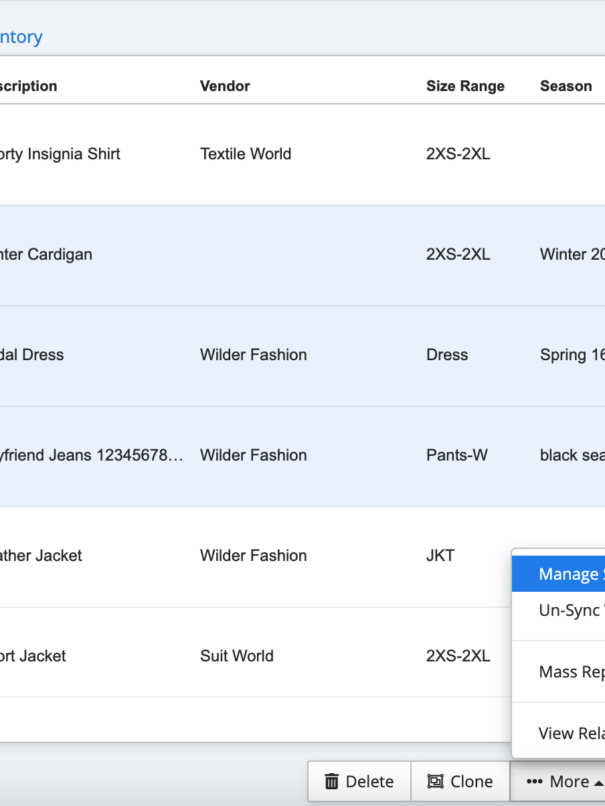Inventory management is one of the foundational elements of a successful retail organization. Retailers and online merchants can cut expenses, increase customer satisfaction, and see an increase in sales by using effective inventory management strategies.
Poor inventory management, on the other hand, causes inefficiencies because you don’t have correct inventory information. This increases the risk of costly business mistakes, such as reordering excess inventory from suppliers or selling nonexistent stock.
This is why we at ApparelMagic have created our retail inventory management system with robust tools and inventory management formulas you can take advantage of in order to make your inventory work for you. And it is why we’re thrilled to impart some of our experience to you in order to help you organize your inventory without stress and make more informed decisions.
In this post, we’ll discuss the significance of retail inventory management, share inventory management tips, and talk about how inventory management techniques can be aided by retail management software.
Photo by Artificial Photography on Unsplash
Inventory Management Meaning: How Does It Work?
In essence, retail inventory management is the process of ensuring that retail companies have the appropriate products, in the appropriate quantities, at the appropriate times. This entails being aware of when your suppliers will deliver products, identifying slow-selling items as efficiently as fast-moving items, determining how much of each item you have on hand in-store, when you’re running low on stock in your distribution centers, how to decide when and what to reorder, and precisely track products—all while keeping your pricing strategy in mind.
The goal of retail inventory management is to maintain the right amount of desired product in stock—neither insufficient inventory nor excess inventory. By effectively managing their inventory and having accurate stock counts, retailers are able to meet customer demand without running out of products and boost customer satisfaction.
Retail inventory management methods and tools provide retailers with more real-time data with which to manage their businesses, such as product locations, quantities of each product type, which stock sells well and which doesn’t, profit margin by style, model, product line or item, the ideal amount of inventory to have in back stock and storage, how many products to reorder and how frequently, etc.
The Importance of Inventory Management in Retail
The days of customers having few shopping options are long gone. In the current situation, a consumer has access to a second brand if they cannot find the requested goods at one retail store. As a fashion retailer, you cannot risk losing even one consumer; retaining current consumers by offering exceptional customer experience and luring new ones are both crucial goals.
When there is no inventory available and the shelves are empty, customers have a negative first impression of the store, making customer returns virtually impossible. Stock management is what prevents this kind of situation, making sure you always have sufficient stock to offer and maintain high levels of customer loyalty and customer satisfaction.
From a strategic point of view, proper inventory management increases efficiency by:
- Minimizing out-of-stocks
- Simplifying processes
- Decreasing inventory costs
- Improving demand forecasting and inventory forecasting
- Improving performance on multiple sales channels
- Preventing spoilage and obsolescence
- Easing supply chain management
- Improving order fulfillment
- Improving profit margins
- Improving customers satisfaction
Best Practices for Retail Inventory Management
Best practices in inventory management set the stage for retailers to achieve higher profit margins, better stock accuracy, reduced expenses, and less shrinkage. So, how then can you control the inventory in your retail space? Here are the top 5 retail inventory management strategies.
Choose your suppliers carefully. You must carefully choose your providers because they are integral to your retail inventory management system. To avoid issues with them and ensure you don’t end up with a bad supplier, conduct a thorough supplier audit, taking into account the cost, stock quality, reputation, and effectiveness of each candidate. Establish early expectations and build a strong relationship with your vendors to manage them effectively. Make it obvious that you and your vendors are partners because your success depends on their efficiency.
Set up stock alerts. You can avoid product shortages at your physical stores by setting up stock alerts. When you set up stock alerts, you can specify a minimum inventory level for each of your products and you will receive stock notifications when the inventory level is getting low.
Apply SKU management techniques. To satisfy customer demand, businesses keep expanding the variety of goods they offer. But that doesn’t imply you should keep excess stock in your retail location, because doing so can actually reduce your business profitability. The practice of SKU (stock keeping unit) management is examining the carrying costs of each SKU item to ascertain which goods are most beneficial to your company. Consider removing some SKUs from your retail store location if they aren’t performing well financially in order to avoid issues like dead stock/dead inventory and phantom inventory.
Adjust the size of your orders. Make every effort to ensure that you place the right stock order at the appropriate moment to meet demand and delight clients. Setting data-backed levels for your safety stock and par stock, being aware of reorder thresholds, using economic order quantity (EOQ) to optimize order sizes, and using the open-to-buy technique to plan purchases are all necessary.
Invest in inventory management software. Manual inventory management can be time-consuming and error-prone. You can automate the tracking process and save a ton of time by using inventory management software. In order to see your physical inventory count in real-time, look for software that interfaces with your shop POS.
Photo by Korie Cull on Unsplash
How Retail Inventory Management Software Works
If you want to be successful, you can’t manage your inventory with spreadsheets. Retailers who use retail management software and retail point-of-sale systems have a number of advantages over those who do not, from managing daily business operations to maintaining effective store inventory control and enhancing stock management. Here are a few ways that retail software can improve your company’s operations and inventory control procedures.
1. Helps you categorize items in your inventory
Keeping track of the items you already have on hand is the main goal of inventory control. In order to help businesses discover their most significant and popular products, the classification of physical inventories is essential. It stops them from wasting too much time and money handling unimportant items.
The ABC technique, based on the Pareto principle, which states that 20% of a retailer’s inventory generates 80% of its sales, is a popular and efficient approach for classifying inventory. It is divided into three groups according to the ABC classification: Group A, which includes the 20% of products that produce 80% of total revenue; Group B, which includes the 30% of products that produce 15% of total revenue; and Group C, which includes the 50% of products that produce 5% of total revenue.
This kind of categorization is crucial because it enables retailers to determine which products fall under certain categories and how to rank inventory purchase requests. ABC analyses can often be automated by retail inventory software solutions, freeing up retailers’ time for other crucial business processes. To categorize things, the software takes into account variables like storage value and frequency of sales.
2. Helps you track all types of product information
There are several ways to identify a product, such as SKUs, suppliers, lot numbers, barcode inventory systems, etc. However, suppliers frequently assign their own SKUs and attach a different product ID to items, which can make monitoring products and placing purchase orders more difficult.
With the aid of inventory management software, you can generate distinctive product IDs and descriptions and keep track of all kinds of product data. Retailers can quickly and easily identify the products they’re looking for thanks to this, which also enables them to tell apart objects that appear similar on the surface.
3. Helps you track and monitor inventory metrics
Attempting to generate inventory metrics using simply a calculator is not a good idea. Using software to actively track inventory metrics will help you make sure that your inventory operations are efficient. If they aren’t, the algorithm points out where they can be improved.
Key parameters such as the stock turnover ratio, GMROI (gross margin return on investment), item fill rate, product performance, and shrinkage can be tracked via inventory management software. These crucial KPIs will show the general health of your company as well as the effectiveness of your inventory management procedures.
4. Helps you set maximum and minimum stock levels
Software for retail inventory management conducts all the legwork to ensure accurate inventory counts.
Some systems create automatic notifications for the maximum and minimum quantity levels that are specified by the user, preventing capital from being locked up in excess inventory or slow-moving products and upsetting customers with insufficient inventory, while others automatically send purchase orders to vendors when you reach a certain stock level or at predetermined intervals.
5. Helps support the right inventory management system
There are many different types of inventory management systems, and as a fashion retailer, it is up to you to decide which one is best for your operation.
As an illustration, some companies decide to track physical counts utilizing the periodic inventory method, which does so at the conclusion of an accounting period (which can be on a weekly, monthly, quarterly, or annual basis). This is perfect for shops that sell products with limited volume and high ticket prices.
The right retail inventory management software will support your chosen inventory management system, contributing to higher efficiency, less warehouse space, and strong sales. The software also promotes better information sharing between the retailer and the supplier, which helps drive down costs for both, as well as for the customers.
The Bottom Line
Spreadsheets and other paper-based inventory management techniques belong to the past. A proper inventory management system is powered by software.
Effective inventory management is no longer only for the larger retailers. Top retail software like ApparelMagic will make your apparel retail business more efficient – regardless of its size, by assisting you in successfully managing your inventory and making informed inventory decisions. Thanks to fashion inventory management integrations with the industry’s best apps and service providers, it can also be used as eCommerce inventory management software. Retail relies on having the appropriate inventory available at the appropriate time, and the more you can automate inventory-related tasks, the simpler fashion inventory management becomes.







